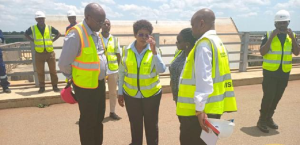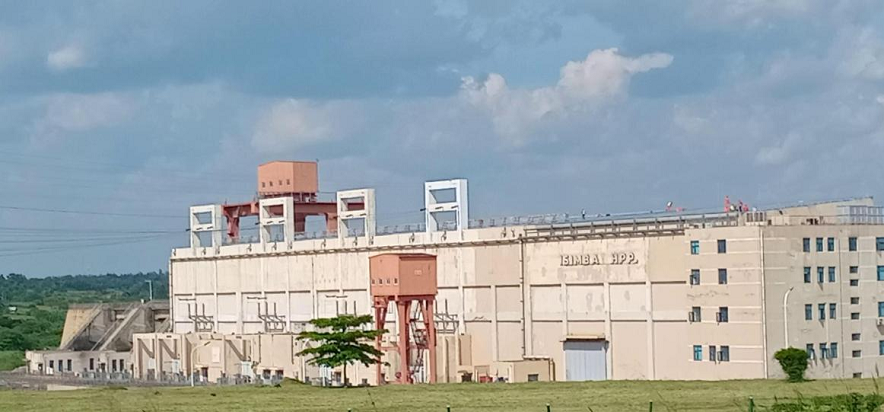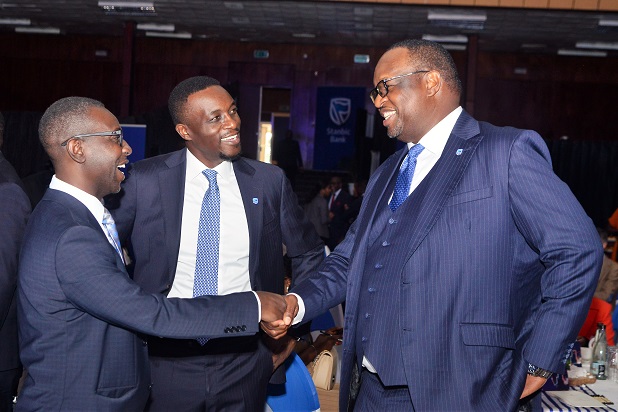Power House at Isimba. Kamya said the powerhouse looks like it has been in place for over fifty years yet is was commissioned about five years ago.
The Inspector General of Government (IGG), Beti Kamya commenced a probe into shoddy work at the 183MW-Isimba hydro power dam.
The IGG’s intervention comes after several years of demands for accountability by a section of Ugandans.
While it was technically established that the works at Isimba were far below the requirements of the owner as stipulated in the contract and as per international standards, nobody has been held liable.
Many have feared that someone might have slept on the job allowing the Engineering, Procurement, Construction, and Commissioning contractor (EPCC) to go on with “shoddy” work without proper supervision at such a turnkey project for Uganda. There is fear that the over two trillion shillings project ($567.7m) could go to waste.
The question is whether the government ombudsman will ensure that someone will be brought to book.
Kamya and her top investigators were at the dam on Friday amidst concerns that it is at growing risk being washed away by flooding.
It was the second time that the IGG was interacting with Uganda Electricity Generation Company, officers from the Attorney General’s chambers and the ministry of energy.
The dam is owned by Uganda Electricity Generation Company Limited (UEGCL) on behalf of the Government of Uganda.
China International Water and Electric Corporation (CIWE) was contracted to construct the dam sitting along River Nile in Kayunga District.
Beti Kamya and team toured inside the power house where the four units of the dam are located.
She was also taken to the spillway. Part of the spillway is not operational because its integrity was severely compromised by the over flooding at the facility in August 2022.
Kamya was told that while the dam is producing all the required 183 MW of power, its spillway is very defective to the extent that it sends vibrations to the entire structure when the gates are opened beyond 40%.
Electricity Generation Company Limited (UEGCL) has noted that the spillways structure and its components are not safe and are unstable based on evidence of concrete damages and erosion.
Kamya held a closed-door meeting with officials led by Harrison E. Mutikanga, the UEGCL Chief Executive Officer. Kamya said she was not impressed by what she and her team had observed from a layperson’s point of view.
“I can see that there are some quality issues, especially with the structure. To me, it looks like a very old structure yet it is a structure that is about five years old,” she said.
The standoff between UEGCL and CIWE
Beti Kamya noted that while some of the defects have been observed by the contractor and UEGCL, the two seemed to be what she described as far apart in appreciating the problem.
“And I think that is a big problem because you can both agree. Yes, we haven’t delivered but we can deliver.” she said.
The critical concern at Isimba
The major point of concern is the quality and standard of the spillway. A spillway is a waterway used to dispose of excess flood waterfrom a reservoir after it has been filled to capacity.
The spillway at Isimba had been designed to evacuate 4,500 Cubic meters (m3) or 4.5 million Liters per second. But currently, UEGCL can discharge less than 40% of what the dam should have evacuated in case of flooding.
There is fear that the powerhouse at Isimba and related structures could be swept away in case of an increase in the water levels.
It is further feared the flooding at the dam could severely impact communities living downstream the river.
Engineer Chad Akita, the UEGCL project manager at Isimba said the spillway has had a number of challenges starting from June 2022 when a diving inspection was conducted at the spillway. He said they identified washouts of buffer blocks and damage to the joints.
“Another inspection was conducted in 2024 by the contractor. And that inspection confirms that these defects are still existing,” Akita revealed.
“They are still existing; they are increasing from the evidence collected. These include gaps with in the slab, we have concrete erosion within the bottom slab. And the main concern here is that the enforcement continues to be enforced,” he added.
Engineer Chad Akita, told our reporter that among the requirements of a spillway is the need to withstand extreme water pressures and the capacity to manage floodwaters.
“The risks are increasing and we need to take some action quickly,” he said.
It also emerged that the way the component of the spillway was designed makes it very difficult to maintain.
The contractor has to higher divers to under the water in case of maintenance. Two divers died at the spillway after the August 2022 flooding which led to the temporary closure of the dam.
We have learned that there had been attempts to carry out under water repairs on the spillway but the work was suspended in February 2024, because of increased water discharge on River Nile.
Engineer Harrison Mutikanga said he always gets sleepless nights because of Isimba dam whenever it rains.
“Because when you have a spillway that is likely not to deal with its flood design capacity, and then you are getting a lot of rain, then you can’t stop worrying. Especially now that the spillway has defects that compromised its functionality,” explained Mutikanga, a civil engineer.
It had been hoped that the contractor would have embarked on long-term spillway rehabilitation works. There were no such rehabilitations by the time the IGG was at Isimba.
A UEGCL official at the site told our reporter that the contractor was “dillydallying”.
Our reporter however witnessed men dressed in orange overalls on top of the powerhouse. Assisted by a yellow crane, the workers were reportedly repairing leakages on the roof of the power house. At the time of commissioning in March 2019, Isimba dam had over 700 defects.
These included leakages in the powerhouse roof, cracks in the powerhouse, internal erosion of the embankment dams, lack of a log boom, poor cabling in the powerhouse among others.
It is suspected the dam which was constructed using embankment technology has manifested the persistent defects because of either poor materials that are not resisting erosion, wear and tear.
Apart from erosions and concrete damages at the spillway, it has also been observed that the water-cooling systems at Isimba are not up to standard. Experts on site say these could severe consequences, including reduced operational efficiency, increased maintenance costs, and potential damage to equipment.
The damages being reported by Electricity Generation Company Limited were allegedly confirmed China International Water and Electric Corporation (CIWE) in December 2024. UEGCL has indicated that CIWE has been inconsistent with its presentation of the condition of the dam.
The manager in charge of CIWE at Isimba was not on site at the time Beti Kamya and her team visited.
She was informed that the manager had traveled to China where he had gone to conduct a Physical Model Test (PMT) to determine the root cause of the structural issues at the third spillway.
The former Energy and Mineral Development Minister, Engineer Irene Muloni had assigned a team of experts led by a structural Engineer, Prof. John Senfuma to investigate the shoddy work at Isimba.
The team had reportedly warned that the dam could burst because of defects. We were not able to get access to the detailed report to find out who caused and was responsible for the mess.
While at Isimba, Kamya was asked why she was taking interest at the particular moment and her possible line of investigation into the matter.
The IGG declined to reveal what she and her team is looking for and how it intends to go about the matter.
She however indicated that “Wherever there is government interest, the Inspector General of Government has jurisdiction. Except by law, the office of the President because it is protected by law. I don’t want to say how far we can get involved. We want to go and evaluate the information that we have received,” said Kamya.

She promised to come out with a preliminary position within three weeks.
So far, part of the blame has been put on Energy Infratech Pvt Limited (EIPL), an Indian firm contracted by the government to act as Owner’s Engineer or supervise works at Isimba and Karuma Power Dams.
The then Minister of Energy, Engineer Irene Muloni in 2017, acting on President Museveni’s directive, suspended EIPL from Karuma and Isimba dams.
Museveni wrote to Irene Muloni in March 2016, calling for prompt action against Energy Infratech Pvt Limited (EIPL) after intelligence reports discovered shoddy work at the two dams. Energy Infratech Pvt Limited (EIPL)’s contract expired on September 7, 2017, after 40 months effective from May 7, 2014.
A project steering team led by Engineer Badiru Kiggundu in 2017 found that EIPL did not mobilize experienced key supervision personnel including quality control specialists, electromechanical specialists and an experienced geotechnical engineer to fully lead in supervision of construction of the embankment dams, in spite of repeated recommendation and calls to fill the agreed project supervision structure.
“This compromised the construction control aspects and, in some instance, led to non-conformance related to material placement and dam monitoring instrumentation for both the left and right embankment dams,” Kiggundu explained in 2017.
According to Kiggundu, the biggest undoing was the change of materials for electro mechanical and hydro mechanical equipment.
“Whereas the EPC contract and employer requirements clearly specified the material properties for equipment like gates, draft tubes, stop logs, cooling system, etc, these were changed to materials of lower or inferior grade compared to what was specified in the contract, under the watch of EIPL.
Our reporter established that despite the suspension of EPIL’s services, the government continued to pay it until its contract expired.
The question is whether the Ministry of energy technical persons looked on while specifications were altered at a whim, works went shoddy with reckless abandon, and timelines negated without restraint.
-URN





